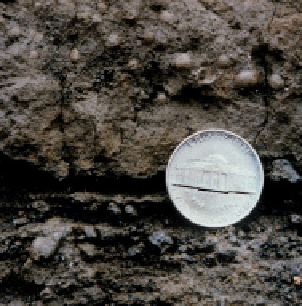Geoscience Reference
In-Depth Information
relationships may help, but sometimes you may be left with
signifi cant doubts.
Rock consisting largely of tuff (consolidated volcanic ash)
brings you into the realm of techniques more familiarly used
to study sedimentary rocks (Chapter 6), even if it is truly
pyroclastic rather than more broadly volcaniclastic in origin.
Ancient fi ne-grained ash deposits that settle to the sea fl oor
can look very much like marine mudstones (even including
the presence of lamination and pelagic fossils) and their true
nature may remain unresolved. Features to look for include
their distinctive colour when fresh (white, bluey grey or
greeny grey), sharp contact, possible grading and (if they have
degraded to montmorillonitic clays) their soft texture.
Identifi cation may need to be confi rmed using thin-sections
or geochemical analysis. More proximal fall deposits may
include accretionary lapilli a few millimetres to about 2 cm
in size (Figure 7.17). These are originally spherical but may
become fl attened during compaction. They typically form
by airborne nucleation in wet conditions, and in cross-
section may reveal a diagnostic concentrically ringed
pattern.
7
Figure 7.17
Accretionary lapilli
in this fall deposit are recognizable
by their spheroidal shape and
(where exposed) their concentric
internal structure. (Peter Francis,
The Open University, UK.)
Often, the most useful record that you can make of a
pyroclastic deposit in the fi eld is a graphic log (Section 6.3).
Fall deposits may show signifi cant grain-size variations. You
are likely to notice these fi rst at a distance, appearing as
sedimentary layers. Individual clasts will be visible, at least in
the coarser-grained horizons, when you get close. In a
pyroclastic fl ow deposit, cross-stratifi cation may be apparent in
addition to variations in the size and composition of clasts.
When making a graphic log of a suspected pyroclastic deposit,
aspects to look out for in particular include:
•
Grain-size variations.
A coarse-grained base fi ning upwards
suggests a discrete explosive eruption, with fi ne-grained
material taking longer to fall out. Possibly there will be a
succession of such events, yielding fi ning-upwards units
with sharp coarse-grained bases separated by hard-to-
quantify time-gaps. On the other hand, if you fi nd grain size
coarsening upwards and then decreasing again (which may
happen repeatedly) you may suspect a sustained eruption
whose strength waxed and waned. If the deposit is
unconsolidated, take samples from different layers to sieve
for grain-size analysis. This can be diagnostic of many
subtleties in the conditions of eruption and/or
emplacement.
•
The nature of clasts.
This is most clearly distinguished in
larger fragments. They may be pumice (representing frothy
magma, evidencing the escape of volatiles that powered the








